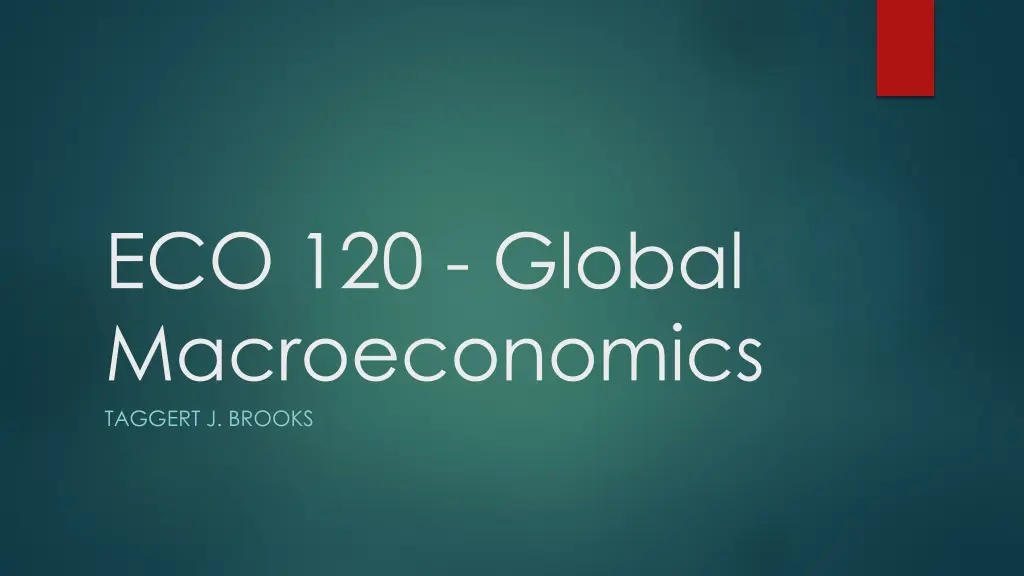
Understanding Economic Growth Factors
Explore the reasons behind differing growth rates in countries, including investment spending, education, and research and development. Learn about the role of human capital in Latin America and East Asia, the importance of R&D, and the government's influence on economic growth through infrastructure development, education spending, and political stability. Discover how excessive government intervention can hinder productivity and growth.
Download Presentation

Please find below an Image/Link to download the presentation.
The content on the website is provided AS IS for your information and personal use only. It may not be sold, licensed, or shared on other websites without obtaining consent from the author. If you encounter any issues during the download, it is possible that the publisher has removed the file from their server.
You are allowed to download the files provided on this website for personal or commercial use, subject to the condition that they are used lawfully. All files are the property of their respective owners.
The content on the website is provided AS IS for your information and personal use only. It may not be sold, licensed, or shared on other websites without obtaining consent from the author.
E N D
Presentation Transcript
ECO 120 - Global Macroeconomics TAGGERT J. BROOKS
Module 39 GROWTH POLICY: WHY ECONOMIC GROWTH RATES DIFFER
Why Growth Rates Differ A number of factors influence differences among countries in their growth rates. Some countries add to their physical capital more rapidly than others, through high rates of investment spending. Some countries add to their human capital through education. Some countries engage in or encourage research and development (R&D) spending to create new technologies and prepare them for practical use.
Why Growth Rates Differ Human Capital in Latin America and East Asia Latin America East Asia 1960 2000 1960 2000 Percentage of population with no schooling 37.90% 14.60% 52.50% 19.80% Percentage of population with high school or above 5.9 19.5 4.4 26.5
Inventing R&D Thomas Edison is best known as the inventor of the light bulb and the phonograph. But his biggest invention was research and development ! In 1875 Edison created something new: his Menlo Park, New Jersey laboratory employed 25 men full-time to generate new products and processes for business. He created an organization whose purpose was to create new ideas year after year.
The Role of Government in Promoting Economic Growth Governments play a direct role in building infrastructure: roads, power lines, ports, information networks, and other parts of an economy s physical capital. Governments also play an important indirect role in making high rates of private investment spending possible. Much of an economy s human capital is the result of government spending on education. Much important R&D is done by government agencies.
The Role of Government in Promoting Economic Growth Political stability and protection of property rights are crucial ingredients in long-run economic growth. Even when governments aren t corrupt, excessive government intervention can be a brake on economic growth. If large parts of the economy are supported by government subsidies, protected from imports, or otherwise insulated from competition, productivity tends to suffer because of a lack of incentives.
The Brazilian Breadbasket In recent years, Brazil s economy has made a strong showing, especially in agriculture. This success depends on exploiting a natural resource, the tropical savannah land known as the cerrado. A combination of three factors changed this land into a useable resource: Technological progress due to research and development Improved economic policies Addition of physical capital
Is World Growth Sustainable? Long-run economic growth is sustainable if it can continue in the face of the limited supply of natural resources and the impact of growth on the environment. Differing views about the impact of limited natural resources on long-run economic growth turn on the answers to three questions: How large are the supplies of key natural resources? How effective will technology be at finding alternatives to natural resources? Can long-run economic growth continue in the face of resource scarcity?
U.S. Oil Consumption and Growth over Time
Economic Growth and the Environment The limits to growth arising from environmental degradation are more difficult to overcome because overcoming them requires effective government intervention. The emission of greenhouse gases is clearly linked to growth, and limiting them will require some reduction in growth. However, the best available estimates suggest that a large reduction in emissions would require only a modest reduction in the growth rate.
Economic Growth and the Environment There is broad consensus that government action to address climate change and greenhouse gases should be in the form of market-based incentives, like a carbon tax or a cap and trade system. It will also require rich and poor countries to come to some agreement on how the cost of emissions reductions will be shared.
The Cost of Climate Protection Many bills have been offered in Congress to reduce U.S. emissions of greenhouse gases. Would implementing these bills stop long-run growth? A study by a team at MIT found that even a strong policy to avert climate change would require that we give up only less than one year s growth over the next four decades.
